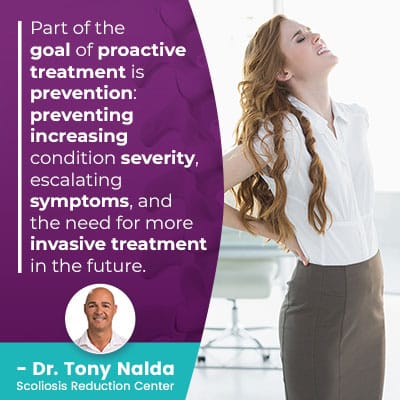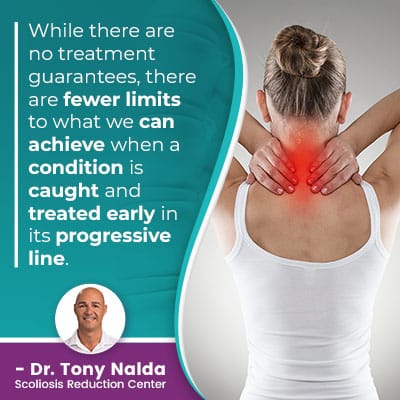How To Prevent Scoliosis From Getting Worse & Progressing

Part of the complexity of treating scoliosis is attributed to its progressive nature. Scoliosis isn’t a static condition, so where it is at the time of diagnosis is not indicative of where it will stay. Scoliosis can start as mild and progress to moderate, severe, and very severe. The condition is highly treatable.
As a progressive condition, scoliosis has it in its very nature to worsen over time, particularly if left untreated, or not treated proactively. The only way to counteract the condition’s progressive nature is proactive treatment that impacts the condition, first and foremost, on a structural level.
Scoliosis is a highly-variable condition, so let’s talk generally about what makes it so, and the parameters that have to be met in order to reach a diagnosis of scoliosis.
Table of Contents
Understanding Scoliosis
The spine’s natural curves make it stronger, more flexible, and better able to absorb stress during movement; if the spine loses one or more of its healthy curves, the biomechanics of the entire spine is disrupted as the health of each spinal curve is dependent on the health of the others.
Being diagnosed with scoliosis means an unnatural sideways spinal curve, with rotation, has developed, and a minimum Cobb angle of 10 degrees.
The rotational component is what makes scoliosis a 3-dimensional condition as it doesn’t just bend, but also twists.
Cobb angle is a measurement taken during X-ray that tells me how far out of alignment a scoliotic spine is and classifies conditions based on severity:
Mild scoliosis: Cobb angle measurement of between 10 and 25 degrees
Moderate scoliosis: Cobb angle measurement of between 25 and 40 degrees
Severe scoliosis: Cobb angle measurement of 40+ degrees
Very-severe scoliosis: Cobb angle measurement of 80+ degrees
As a progressive condition, scoliosis has it in its nature to worsen over time, especially if left untreated, or not treated proactively.
Scoliosis can easily progress from mild to moderate, severe, and very severe, and the only way to counteract its progressive nature is through proactive treatment that, first and foremost, impacts the condition on a structural level.
Scoliosis progressing means the unnatural spinal curve is increasing in size, the uneven forces introduced by the condition are increasing, and symptoms are likely becoming more noticeable.
 Part of the goal of proactive treatment is prevention: preventing increasing condition severity, escalating symptoms, and the need for more invasive treatment in the future.
Part of the goal of proactive treatment is prevention: preventing increasing condition severity, escalating symptoms, and the need for more invasive treatment in the future.
So what types of treatment can prevent scoliosis from getting worse & progressing?
Scoliosis Treatment Options
There are two main scoliosis treatment approaches for patients to choose between, and understanding the difference is important because each produces a different kind of outcome.
Traditional surgical scoliosis treatment was the dominant choice for many years, but a modern non-surgical conservative scoliosis treatment approach has evolved, with proven results.
Traditional Scoliosis Treatment
Traditional scoliosis treatment is described as more reactive than proactive and strives to stop progression as its end goal.
The reality is that scoliosis is easiest to treat when it’s at its mildest, the spine is at its most flexible, is going to be the most responsive to treatment, and before the body has adjusted to the unnatural curve’s presence.
Those on the path of traditional treatment with mild scoliosis are commonly told that as it’s mild, they need only to watch and wait for signs of further progression.
Now, the condition’s most-prevalent type is adolescent idiopathic scoliosis (AIS), diagnosed between the ages of 10 and 18, so this is the form we’ll currently focus on, and this age group is at risk for rapid-phase progression, and this is due to growth.
We don’t fully understand why AIS initially develops, but we know what triggers it to progress: growth and development.
In between periodic assessments for progression, a significant growth spurt can occur, and significant progression as a result, and now, the condition is more challenging to treat.
The traditional approach doesn’t have a strategy for treating scoliosis while mild, so waits for conditions to progress into the severe classification, when they can be funneled towards spinal fusion surgery.
While spinal fusion, when successful, can prevent scoliosis from getting worse & progressing, it comes with some serious potential risks, side effects, complications, and often comes at the cost of the fused spinal section’s flexibility and range of motion.
There is, however, another treatment option that can counteract the condition’s progressive nature through a more natural and less-invasive type of treatment: chiropractic centered conservative treatment.
Conservative Scoliosis Treatment
Here at the Scoliosis Reduction Center, I believe in the merits of proactive treatment applied as close to the time of diagnosis as possible; I don’t want to waste valuable treatment time.
For my mild scoliosis patients, the benefits of early detection are only available to those whose diagnosis is responded to with proactive treatment.
 While there are no treatment guarantees, there are fewer limits to what we can achieve when a condition is caught and treated early in its progressive line.
While there are no treatment guarantees, there are fewer limits to what we can achieve when a condition is caught and treated early in its progressive line.
The complex nature of scoliosis also necessitates a customized treatment approach, so each patient’s treatment plan will be unique and crafted around key patient/condition characteristics: patient age, curvature location, condition type (cause), and severity.
By integrating multiple forms of treatment, scoliosis can be impacted on every level.
As a structural condition, first and foremost, scoliosis has to be impacted on a structural level, and this is worked towards through condition-specific chiropractic care.
Chiropractic Care
As a CLEAR-certified scoliosis chiropractor, I know the spine, how scoliosis affects it, and how to best treat it.
Through a series of chiropractic techniques and manual adjustments, I can work towards repositioning the most-tilted vertebrae at the curve’s apex back into alignment with the rest of the spine.
A spine that’s better aligned means a spine that has more of its healthy curves in place, and this helps improve overall spinal biomechanics, health, and function.
It’s not just the spine that’s in charge of maintaining its natural curves and alignment, but also its surrounding muscles, which is where a variety of therapies comes in.
In-Office Therapy
The spine receives support from its surrounding muscles, so part of preventing scoliosis from getting worse involves increasing core strength so the spine is optimally supported.
A symptom of scoliosis is also sore and strained muscles, as they struggle to support an unnaturally-curved spine, as well as muscle imbalance, so in-office therapy can help patients become stronger, while addressing muscle pain and imbalance.
In addition, certain scoliosis-specific exercises (SSEs) are known to activate specific areas of the brain for improved brain-body communication, postural remodeling, and better body positioning.
Corrective bracing is another facet of conservative treatment that can augment corrective results.
Corrective Bracing
While traditional bracing is associated with a number of shortfalls, modern corrective bracing addresses those shortfalls in its ultra-corrective customized design.
By pushing the spine into a corrective position, the ScoliBrace can help prevent scoliosis from getting worse, while augmenting corrective results achieved through other treatment disciplines.
Custom-Prescribed Home Exercises
Although scoliosis is an incurable progressive condition, it is highly treatable, and part of proactive treatment is using custom-prescribed exercises to help patients establish a home-rehabilitation program to further stabilize the spine for sustainable results.
So part of preventing scoliosis from getting worse continues after treatment. I compare this to an adolescent who gets braces for crooked teeth. Once the braces have changed the structure of the teeth, they can come off, but retainers commonly have to be worn to hold those results.
After successful conservative treatment, some condition-specific home exercises and periodic visits to a scoliosis chiropractor can hold the curvature reduction where it is, while preserving as much of the spine’s natural function as possible.
Here at the Center, my patients have access to multiple treatment disciplines, and the benefits of each, under one roof.
I believe in the power of proactive treatment to prevent scoliosis from getting worse, causing escalating symptoms, and the need for more invasive surgical treatment in the future.
Conclusion
The key to managing scoliosis effectively is being proactive; scoliosis is not a static condition, so proactive treatment has to be applied to counteract the condition’s progressive nature and prevent it from getting worse.
While traditional scoliosis treatment approaches managing progression through spinal fusion surgery, this is an invasive procedure that can cost the spine in terms of its flexibility and range of motion.
Conservative chiropractic-centered treatment integrates multiple forms of treatment to impact the condition on every level, first structurally by reducing the curve, and once those results are seen, working towards increasing core strength for optimal spinal support, and rehabilitation for further spinal stabilization and long-term sustainable results.
Regardless of patient age or severity, the right time to seek out treatment that works to prevent scoliosis from getting worse is always now.
Dr. Tony Nalda
DOCTOR OF CHIROPRACTIC
After receiving an undergraduate degree in psychology and his Doctorate of Chiropractic from Life University, Dr. Nalda settled in Celebration, Florida and proceeded to build one of Central Florida’s most successful chiropractic clinics.
His experience with patients suffering from scoliosis, and the confusion and frustration they faced, led him to seek a specialty in scoliosis care. In 2006 he completed his Intensive Care Certification from CLEAR Institute, a leading scoliosis educational and certification center.
About Dr. Tony Nalda
 Ready to explore scoliosis treatment? Contact Us Now
Ready to explore scoliosis treatment? Contact Us Now





